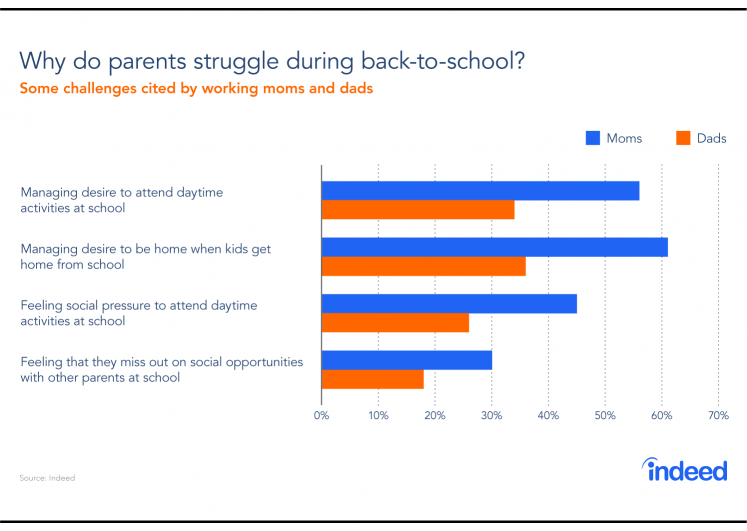For many, if not most working women and moms, back-to-school is quite the stressful time. New schedules to coordinate, childcare to secure, administrative duties to take care of, all the while juggling the rest of their commitments because life doesn’t stop because school is back in session. If anything, the intense post-summer rhythm ends up taking a toll on working women and moms, affecting their mental and physical well-being, as well as their careers and even personal relationships…This is especially more acute when working women and moms do not have the necessary support to handle all the related changes, from infrastructure to community support. Not to mention the financial toll that comes with the heightened school-related expenses for parents…
It’s no wonder then that, many working moms and parents in general, dread the back-to-school period. An Indeed survey reveals 84% of mothers and 85% of dads are taken by surprise by the back-to-school challenges. A majority of moms (94%) tend to feel that the chores and childcare are their responsibility, which also puts a strain on marriages and partnerships. In addition, moms also tend to deal with managing the desire to be present during daytime activities at school, welcome the kids home, and take advantage of social opportunities with fellow parents, along with the societal pressure that accompany these. Considering the number of dual-earning households where both parents have to work, this can pose serious problems in terms of coordinating schedules, leading successful careers and having harmony at home.

For many, if not most moms, these pressures directly conflict with getting back to a more intense work and family pace for the last months of the year. This adds itself to the pressure to finish the year well, and successfully meet deadlines and deliverables before the end of the year. While the COVID-19 pandemic may have opened a wider door to remote and flexible work arrangements, increasing the number of women in the workforce, it’s also created increased childcare issues and is burdening women with handling both the home and work front simultaneously.

As such, developing a back-to-school system that works best for each working mom can go a long way towards lessening the frustration, guilt, and even home and work issues that often arise at the end of the summer months. Here are three steps to consider:
- Developing a vision and plan for the back-to-school season:
As mentioned earlier, the back-to-school season takes many parents by surprise. The sheer amount of tasks and coordination involved leaves many a working mom especially frazzled and stressed out. One of the main reasons for this is, as many tend to not give thought to it earlier in the summer, they underestimate the breadth of what is involved. If we add to it current childcare shortages, increasing inflation and other societal, political, and economic pressures, the whole thing can end up turning into the perfect parental and family storm.
Hence the need to develop a vision and plan beforehand. This involves starting at least a couple of weeks earlier, considering all individuals involved, including parents and children, but also the communities around, the schools and workplaces involved as well. How do we want the back-to-school season to feel? What errors and mistakes do we want to avoid?
Putting together all the schedules of all individuals and places involved allows to spot and fill in the blanks, that is all those times, commitments and duties that may require assistance and support, and find ways to approach these.
- Set up a communication plan:
Very often, especially as working moms, we fail to communicate our needs and expectations, especially during harsh seasons. Being so accustomed to literally doing it all, or doing most of it, has robbed many of the skill to ask for help. As a result, overwhelm, frustration, even burnout ensue, unfortunately leaving us depleted and drained. This is where setting up an effective communication plan is crucial.
This entails communicating personal and professional needs and expectations, as related to scheduling, administrative tasks, school and family events as well as finances to the units that make up our communities, including home, work, schools, and the villages we operate in. Some examples include asking for remote and flexible work arrangements, coordinating schedules with partners and family support, or asking for teachers’ assistance.
- Take action!
Last but not least, the last part of this system is to take consistent and dedicated action towards making this back-to-school system work. Change requires preparation and consistent action, and back-to-school changes are no exception. This is where implementing small modifications to personal, professional and family habits come in handy, such as progressively modifying bedtimes and wake-up times or slowly reinforcing daily study habits. Stacking habits, whereby new habits are built upon already existing ones, such as scheduling study time right after breakfast, can also help.
Most importantly, maintain the consistency of small changes over time makes all the difference. Involving the whole family, setting up a rewards system, or regularly motivating everyone can go a long way to keep at it!
All in all, back-to-school, while being a busy time for working moms and working parents/families as a whole, doesn’t need to be a time of struggle, frustration and anxiety. Setting up a solid system based on a strong vision and plan, adequate communication and consistent action can help transform a usually dreaded time of year, into one of successful transition.
What are your tips for a successful back-to-school season?
The Corporate Sis.







